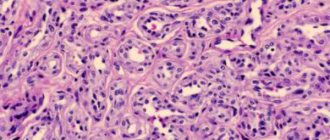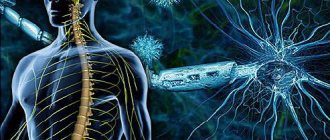Why do tumors appear in healthy brain tissue? The answer to this question will sooner or later be given by the results of numerous scientific studies, but so far scientists are only on the way to understanding the underlying mechanisms of oncogenesis.
Although the exact causes of brain tumors have not yet been established, the so-called “risk factors” that can trigger the development of the disease have been quite well studied.
The likelihood of a tumor developing in the brain may increase due to:
- aggressive influence of the external environment (environmental risk factors);
- poor heredity, as well as a decrease in natural immune defense and metabolic disorders as we age (genetic risk factors).
Causes
- Infections
- Smoking
- Poor nutrition
- Sedentary lifestyle
- Carcinogens
- Contaminated air
- Excessive drinking
The causes of the formation of malignant tumors are varied. In a large percentage of cases, the etiology of the neoplasm remains unclear. There are many external and internal factors that can cause disruption of the cellular genome. These factors are called carcinogenic.
External influences are divided into physical (for example, solar ultraviolet radiation), chemical (industrial compounds, some medications, etc.) and biological (oncoviruses - for example, the Epstein-Bar virus).
Internal factors include hormonal disorders, chronic diseases of internal organs, both inflammatory and non-inflammatory in nature, leading to chronic tissue hypoxia and decreased activity of the immune system (loses the ability to recognize atypical cells in time and destroy them).
Malignant tumors can develop from benign growths that precede them, so-called precancerous diseases. This transformation of a benign tumor into a malignant one is called malignancy.
With the progression of the disease, the occurrence of damage to vital organs, metastasis, the development of anemia due to bleeding from an ulcerated tumor and intoxication of the body with products of tumor decay and metabolic disorders, cachexia (exhaustion) may occur.
Also, with malignant neoplasms, paraneoplastic syndromes may occur, characterized by metabolic, endocrine disorders, skin lesions, central nervous system, neuromuscular disorders, allergic reactions, etc.
Gene therapy and viruses
The human immune system can fight cancer itself. But why doesn't this happen? The fact is that cancer disguises itself as normal, healthy human cells, so the immune system does not recognize it. For example, cancer cells from leukemia patients have the CD19 protein on their surface, which disguises malignant cells as normal, and they remain undetected by the human immune system. Scientists have found a way to add CD19 receptor genes to the lymphocytes of patients and return the altered cells to the body of patients with leukemia using neutralized retroviruses that have the ability to integrate into human DNA. The cancer cells that lost their camouflage were attacked by modified lymphocytes. 90% of subjects with severe leukemia recovered.
Medicines for gene therapy were also invented in Russia. For example, the drugs AntionkoRAN-M and AntionkoRAN-F add 2 genes: one kills malignant cells, and the other stimulates the immune system. To continue research, about 150 million rubles are needed. Executive Director Maxim Koksharov in an interview calls for investing not in Bitcoin, but in a cure for cancer.
The possibilities of using viruses for gene therapy are being actively studied:
| measles virus | does not induce a protective response in cancer cells |
| Herpes virus | capable of transferring long sequences of “built-in” genes |
| Lentivirus (HIV derivative) | can “incorporate” genes into non-dividing cells |
| Retrovirus | integrates into a foreign genome and ensures stability of changes |
Diagnosis of malignant tumors
Diagnosis of malignant tumors is carried out using various laboratory and instrumental methods. Specific methods include determining the level of tumor markers in the blood. The diagnosis is confirmed by histological and cytological examination.
Basic diagnostic methods:
- Patient examination
- Radiography
- MRI (Magnetic resonance imaging)
- (CT scan)
- Ultrasound (ultrasound examination)
- PET-CT
- Cancer screening
- Mammography
- Fibroscopy
- Laboratory research
- Radionuclide diagnostics
- Thermography
Has a cure for cancer been found?
"How so?" - you might think. “So the cure for cancer has already been found?”
Unfortunately, this is not entirely true. As we wrote above, there are many types of cancer.
For example, blood cancer includes leukemia, hematosarcoma, lymphoma, angioma, chronic myeloid leukemia, acute lymphoblastic leukemia, acute monoblastic leukemia... So far, scientists have been able to fight only some types of cancer.
None of the targeted methods of combating cancer found to date give 100% results.
A universal cure for all types of cancer has not been found.
But there are medicines for some of its types, the use of which shows a high percentage of the likelihood of remission: Leukeran, Gleevec, Nivolumab, Herceptin, Afatinib, Tamoxifen, Ftorafur ... All medicines and methods act purposefully, for example, Gleevec allows you to treat chronic myeloid leukemia, which was previously fatal diagnosis.
The search for new drugs for cancer is constantly underway. Therapy aimed at fighting cancer by stimulating the human immune system is considered one of the most promising areas. Such treatment costs more than 100 thousand dollars a year.
New ways to fight cancer have already been developed, but they are not so widely known. Not only for patients, but also for doctors.
Many treatment options have not yet been fully explored.
Treatment of malignant tumors
Treatment of malignant neoplasms is carried out:
- by surgical removal of the tumor,
- as well as radiation therapy methods,
- chemotherapy,
- hormonal treatment,
- immunotherapy
- targeted therapy
Operation options:
- Radical therapy
- Palliative care
- Symptomatic surgery
If a tumor develops from epithelial tissue cells, it is called cancer.
High-precision radiation therapy: gamma knife and cyber knife.
Conventional chemotherapy destroys both damaged and healthy cells - and this is its disadvantage. But scientists have developed a new type of radiation therapy - proton therapy. Protons are accelerated in a proton accelerator and the radiation is directed precisely at the tumor. Protons destroy cancer cells, leaving healthy tissue surrounding them undamaged. In this way, hard-to-reach tumors of the brain and spinal cord are removed.
High-precision radiation therapy technologies were developed back in the 1960s in Sweden. The radiation was directed to one point - the invention was called the gamma knife. Later, John Adler created a cyber knife based on the gamma knife. The Cyber Knife uses a computer system to direct radiation with microscopic precision. With the help of high-precision radiation therapy, small formations that are located in hard-to-reach places are already removed.
Disease prognosis
The prognosis of the disease is influenced by many factors. It is important to take into account the stage of tumor development, the area where the focal areas are located, the structure of the growth, the general well-being of the patient facing an oncological manifestation, as well as the age category of the patient. When answering the question of how long cancer patients live, you need to study the listed factors. Five-year survival for people with cancer is calculated individually, depends on the specified nuances and varies from 15% to 95%.
Malignant cancer is considered the most dangerous; the prognosis reveals an unfavorable outcome due to the increased growth of metastases. The current situation leads to an increase in the percentage of deaths. Determining the outcome of treatment for patients with low-quality cells depends on:
- location of the pathology;
- age of the patient;
- stage of development;
- production of metastases;
- forms and structures of neoplasms;
- method of surgical manipulation.
Over the past ten years, experts have noted an increase in cancer incidence. The most difficult cancers to cure are those of the lung, gastrointestinal tract, liver, breast, and kidney pathology. And lung cancer is called in situ cancer.
Are genetic methods of fighting cancer dangerous?
Any manipulation of genes is a certain risk, because in the future may lead to uncontrolled genetic mutations. Changing human genes, along with cloning, is fully or partially limited by law in many countries. In the process of developing gene therapy methods, scientists ensure that altered genes are not inherited.
3 Gene Drugs for Cancer That Already Exist
In August 2020, Forbes magazine announced a new era in global clinical practice. An article was published on the first legislatively approved gene therapy for the treatment of cancer using genetically modified CAR-T lymphocytes. The therapy was named Kymriah . The remission rate with this type of treatment is 83%. CAR-T, however, also has serious and potentially fatal side effects, cytokine storm, anemia, and temporary brain damage, including death. The developer of the method, Novartis, set the price for a one-time treatment at $475,000.
In October 2020, the same journal announced that gene therapy was on stream and announced the approval of a second drug, Yescarta, from Gilead Science Corporation. A course of Yescarta treatment costs $350,000, which is cheaper than Novartis' Kymriah. The drug is intended for the treatment of B-cell lymphoma using the same technology -.
Keytruda (Pembrolizumab), approved by the FDA in September 2017, should be added to this list Developed by the multinational company Merck Sharp & Dohme. This drug has been used to treat oncology in Israel since 2014. In November 2020, pembrolizumab was first registered in Russia.
You can read more about what other drugs are under development and research here: https://mosmedpreparaty.ru/news/5178
Melanoma
Melanoma is a malignant neoplasm that is formed from pigment cells that produce melanin . In most cases, it affects the skin surface, sometimes developing on the retina or mucous membranes.
It is considered an extremely dangerous form of the disease, since there is a high probability of metastases. In addition, in the initial stages there are no pronounced symptoms, so it is quite difficult to diagnose it in a timely manner.
In this regard, a person with such oncology seeks help too late, when it is no longer possible to carry out effective treatment.
Melanoma can be detected by systematically examining moles. For example, they change color, shape, or begin to hurt - any of these signs is considered sufficient to contact a specialist.
It is worth considering that the probability of survival in the last stages is extremely low: 3 – more than 70% of people do not survive the 5-year period after diagnosis, and in stage 4 less than 10% survive.
Why do menstruation begin after removal of uterine fibroids using the laparoscopic method and what should be done in this case. This article describes the signs of kidney cancer. Distinctive symptoms in women.
And here https://stoprak.info/vidy/onkologicheskie-zabolevaniya-krovi/limfaticheskaya-sistema/kishechnika-etiologiya-klinicheskaya-kartina-vyzhivaemost.html symptoms of intestinal lymphoma.











